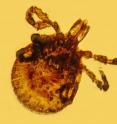Amber discovery indicates Lyme disease is older than human race
Related images
(click to enlarge)
Lyme disease is a stealthy, often misdiagnosed disease that was only recognized about 40 years ago, but new discoveries of ticks fossilized in amber show that the bacteria which cause it may have been lurking around for 15 million years -- long before any humans walked on Earth. The findings were made by researchers from Oregon State University, who studied 15-20 million-year-old amber from the Dominican Republic that offer the oldest fossil evidence ever found of Borrelia, a type of spirochete-like bacteria that to this day causes Lyme disease. They were published in the journal Historical Biology.
In a related study, published in Cretaceous Research, OSU scientists announced the first fossil record of Rickettsial-like cells, a bacteria that can cause various types of spotted fever. Those fossils from Myanmar were found in ticks about 100 million years old.
As summer arrives and millions of people head for the outdoors, it's worth considering that these tick-borne diseases may be far more common than has been historically appreciated, and they've been around for a long, long time.
"Ticks and the bacteria they carry are very opportunistic," said George Poinar, Jr., a professor emeritus in the Department of Integrative Biology of the OSU College of Science, and one of the world's leading experts on plant and animal life forms found preserved in amber. "They are very efficient at maintaining populations of microbes in their tissues, and can infect mammals, birds, reptiles and other animals.
"In the United States, Europe and Asia, ticks are a more important insect vector of disease than mosquitos," Poinar said. "They can carry bacteria that cause a wide range of diseases, affect many different animal species, and often are not even understood or recognized by doctors.
"It's likely that many ailments in human history for which doctors had no explanation have been caused by tick-borne disease."
Lyme disease is a perfect example. It can cause problems with joints, the heart and central nervous system, but researchers didn't even know it existed until 1975. If recognized early and treated with antibiotics, it can be cured. But it's often mistaken for other health conditions. And surging deer populations in many areas are causing a rapid increase in Lyme disease -- the confirmed and probable cases of Lyme disease in Nova Scotia nearly tripled in 2013 over the previous year.
The new research shows these problems with tick-borne disease have been around for millions of years.
Bacteria are an ancient group that date back about 3.6 billion years, almost as old as the planet itself. As soft-bodied organisms they are rarely preserved in the fossil record, but an exception is amber, which begins as a free-flowing tree sap that traps and preserves material in exquisite detail as it slowly turns into a semi-precious mineral.
A series of four ticks from Dominican amber were analyzed in this study, revealing a large population of spirochete-like cells that most closely resemble those of the present-day Borrelia species. In a separate report, Poinar found cells that resemble Rickettsia bacteria, the cause of Rocky Mountain spotted fever and related illnesses. This is the oldest fossil evidence of ticks associated with such bacteria.
In 30 years of studying diseases revealed in the fossil record, Poinar has documented the ancient presence of such diseases as malaria, leishmania, and others. Evidence suggests that dinosaurs could have been infected with Rickettsial pathogens.
Humans have probably been getting diseases, including Lyme disease, from tick-borne bacteria as long as there have been humans, Poinar said. The oldest documented case is the Tyrolean iceman, a 5,300-year-old mummy found in a glacier in the Italian Alps.
"Before he was frozen in the glacier, the iceman was probably already in misery from Lyme disease," Poinar said. "He had a lot of health problems and was really a mess."

